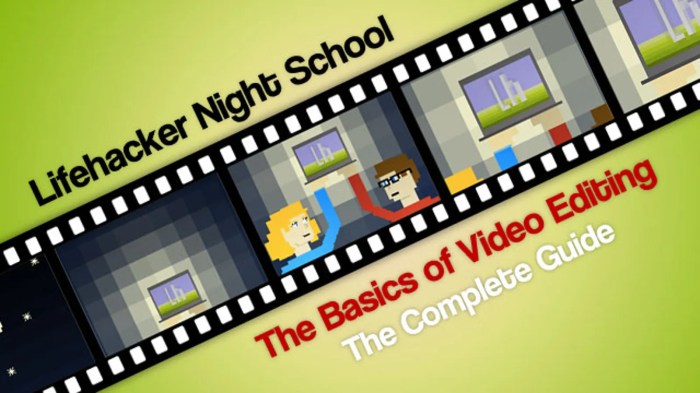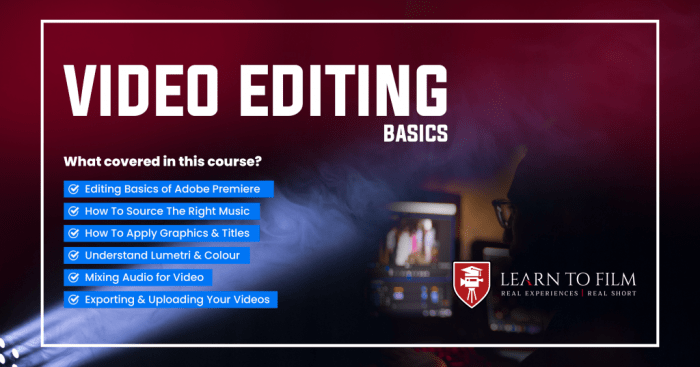Video Editing Basics sets the stage for diving deep into the world of creating compelling visual stories through editing. Get ready to explore the fundamental principles and techniques that will take your videos to the next level.
From understanding key elements to mastering efficient editing tips, this guide will equip you with the knowledge and skills needed to unleash your creativity in the editing room.
Introduction to Video Editing Basics

Video editing is the process of manipulating and rearranging video shots to create a new video. It involves adding effects, transitions, music, and more to enhance the visual storytelling experience.
The importance of video editing in the filmmaking process cannot be overstated. It is where the magic happens – transforming raw footage into a polished final product that engages and captivates audiences. Without proper editing, even the best footage can fall flat.
Popular Video Editing Software, Video Editing Basics
- Adobe Premiere Pro: A professional-level editing software used by many filmmakers and video editors.
- Final Cut Pro: Another popular choice among video editors, especially for Mac users.
- Davinci Resolve: Known for its powerful color correction tools and used by both amateur and professional editors.
- Sony Vegas Pro: A user-friendly option for those new to video editing, offering a range of features for creating videos.
Understanding Video Formats
Video formats play a crucial role in video editing, affecting the quality, file size, and compatibility of the final product. It is essential to understand the common video formats used in video editing, the difference between lossy and lossless compression, and how video formats impact the editing process.
Common Video Formats
- H.264: Known for its high compression ratio and quality, widely used for online streaming and video sharing platforms like YouTube.
- ProRes: Apple’s professional video editing format, offering high quality and efficiency during post-production.
- AVI: Audio Video Interleave, a standard format for Windows systems, but with larger file sizes compared to other formats.
Lossy vs. Lossless Compression
Lossy compression reduces file size by eliminating some data, resulting in a loss of quality. On the other hand, lossless compression maintains all original data without quality loss but leads to larger file sizes. Video editors must balance between file size and quality based on the project’s requirements.
Impact on the Editing Process
- Editing with lossy compressed files may lead to further quality loss, requiring careful adjustments to maintain the video’s integrity.
- Lossless formats preserve quality but may require more storage space and processing power, impacting editing efficiency.
- Choosing the right format at the beginning of the editing process can streamline workflow and ensure the desired output quality.
Key Elements of Video Editing
Video editing involves several key elements that are crucial to creating a compelling and professional-looking video. Understanding these elements and how they work together is essential for producing high-quality content.
Sequencing and Pacing
Sequencing and pacing are fundamental aspects of video editing that can greatly impact the viewer’s experience. The way you arrange and time your shots can determine the flow and rhythm of your video. By carefully sequencing your clips and adjusting the pace of the edits, you can create a narrative that captures and maintains the audience’s attention throughout the video.
Transitions
Transitions play a vital role in creating a cohesive video by smoothly connecting different shots and scenes. They help maintain the continuity of the story and guide the viewer from one scene to the next without causing distraction. Whether it’s a simple cut, fade, or a more elaborate transition effect, choosing the right transition can enhance the overall viewing experience and make your video look polished and professional.
Audio Editing
Audio editing is equally important in conjunction with video editing, as sound can significantly impact the mood and atmosphere of a video. By adjusting the volume levels, adding background music, or incorporating sound effects, you can enhance the overall quality of your video and create a more immersive viewing experience for your audience. Paying attention to audio details can elevate the production value of your video and make it more engaging and memorable.
Basic Video Editing Techniques
In video editing, mastering basic techniques is essential to creating professional-looking videos. Here are some fundamental skills to get you started:
Cutting and Trimming Video Clips
To cut and trim video clips, follow these steps:
- Import your video clip into the editing software.
- Drag the clip to the timeline.
- Use the razor tool to cut the clip at the desired points.
- Delete the unwanted sections.
- Use the selection tool to trim the clip by dragging the edges.
- Preview the edited clip to ensure smooth transitions.
Adding Text Overlays and Titles
To add text overlays and titles to a video, here’s how:
- Select the text tool in the editing software.
- Choose the font, size, color, and placement of the text.
- Type in the desired text for the overlay or title.
- Adjust the duration of the text on the screen.
- Ensure the text is legible and complements the video content.
Color Correction and Grading Techniques
Color correction and grading can greatly enhance the overall quality of your video. Here are some techniques to improve the color:
- Adjust the brightness, contrast, and saturation levels to achieve the desired look.
- Use color wheels or curves to fine-tune the colors in the video.
- Apply color presets or LUTs (Look-Up Tables) for quick color grading.
- Match the color tones throughout the video for consistency.
- Experiment with different color effects to stylize your video according to the mood or theme.
Tips for Efficient Video Editing

When it comes to video editing, efficiency is key to producing high-quality content within a reasonable timeframe. Here are some tips to help you streamline your editing process and work more effectively.
Shortcuts and Hotkeys
Using shortcuts and hotkeys can significantly speed up your editing process. Instead of relying solely on mouse clicks, learn the keyboard shortcuts for common editing tasks like cutting, trimming, and adding transitions. This will help you work faster and more efficiently, ultimately saving you time during the editing process.
Organizing Media Assets
Organizing your media assets is crucial for easy access during the editing process. Create a clear folder structure for your video files, audio tracks, and other assets, and label them appropriately. This will help you quickly locate the files you need and prevent unnecessary delays in finding the right content for your video project.
Creating a Storyboard
Before diving into the editing process, it’s essential to create a storyboard that Artikels the sequence of shots, transitions, and effects you want to include in your video. A storyboard acts as a roadmap for your editing process, helping you visualize the final product and make editing decisions more efficiently. By planning out your video in advance, you can save time and ensure a more cohesive and engaging final product.